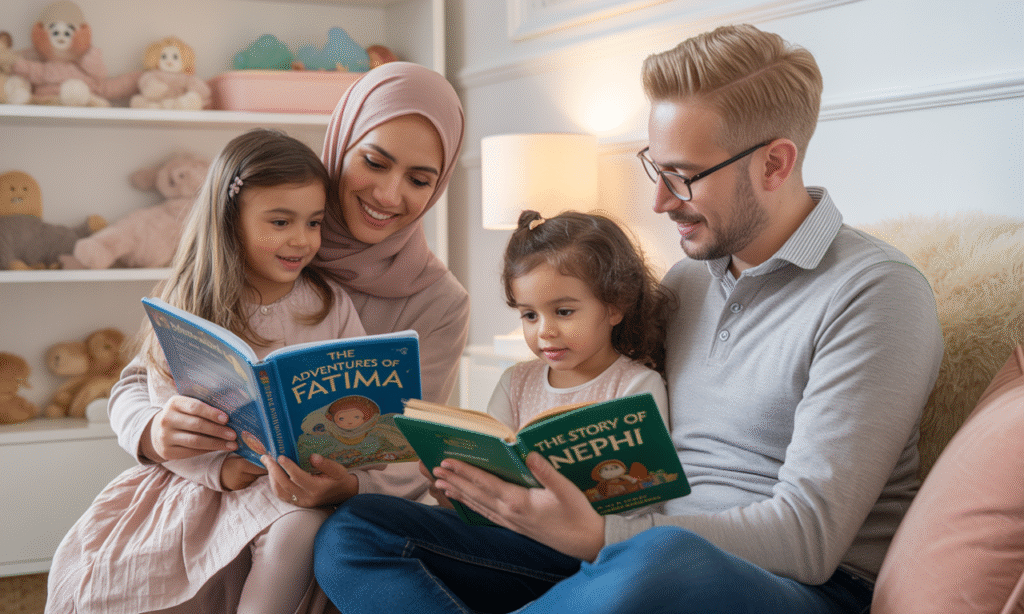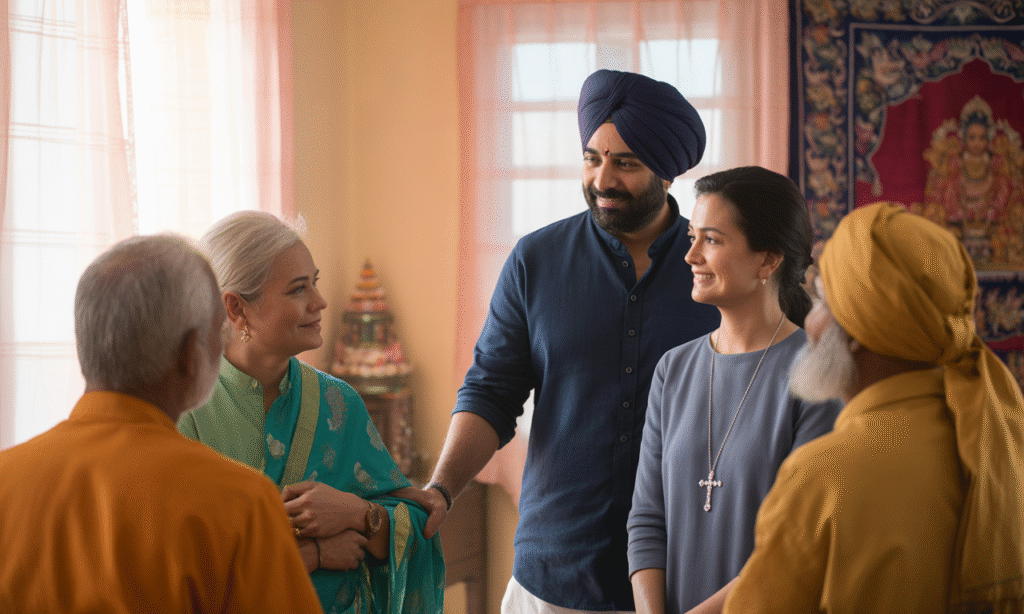Faith Under One Roof: Navigating Religious Differences in Marriage

When two people from different religious backgrounds fall in love, the heart leads—but the details, including interfaith marriage communication, can get complicated.
Shared values, mutual respect, and deep emotional connection often draw couples together. But once the honeymoon period fades and real-life decisions take center stage—like how to worship, how to celebrate holidays, and how to raise children—religious differences can become a source of tension.
Whether one spouse practices a faith and the other doesn’t, or whether both hold strong yet differing beliefs, navigating those differences with love and intentionality is essential. The good news? Many couples not only survive these differences—they build marriages that are stronger because of them.
This post explores how couples can live in spiritual harmony—even if they don’t share the same religion. You’ll find guidance, conversation tips, and examples of how to keep faith from becoming a wedge, and instead, use it as a bridge.
1. Recognize That Religion Is Deeply Personal
 Before diving into solutions, it’s crucial to acknowledge just how deeply personal and emotional religion can be.
Before diving into solutions, it’s crucial to acknowledge just how deeply personal and emotional religion can be.
Faith is more than a set of beliefs—it’s often a foundation of identity, tradition, family history, and moral compass. It influences everything from how someone sees the world to how they process suffering and joy.
So when your spouse’s faith—or lack thereof—differs from yours, it’s not just about theology. It’s about understanding their core values and emotional truths.
Instead of viewing differences as a threat, view them as an invitation:
“Tell me what your faith means to you.”
2. Start with Respect, Not Conversion
 One of the biggest mistakes interfaith couples make is trying to convert each other—either overtly or subtly.
One of the biggest mistakes interfaith couples make is trying to convert each other—either overtly or subtly.
Trying to “win” your partner over to your side may seem loving (“I just want you to know the truth”), but it can often feel invalidating or coercive. Over time, this creates emotional distance and resentment.
Instead, start with radical respect:
- “I may not fully understand your beliefs, but I honor that they’re important to you.”
- “I want to learn about your faith—not to debate it, but to understand your heart.”
This doesn’t mean you can’t share what you believe—it just means the goal is connection, not conversion.
3. Create a Safe Space for Spiritual Conversations
 Spiritual conversations can be some of the most vulnerable. That’s why they require an emotionally safe space—one free from sarcasm, judgment, or interruption.
Spiritual conversations can be some of the most vulnerable. That’s why they require an emotionally safe space—one free from sarcasm, judgment, or interruption.
Set aside intentional time to talk about your beliefs. Use prompts like:
- “What did you grow up believing about God?”
- “Has your faith changed over time?”
- “What parts of my religion are confusing or interesting to you?”
- “Are there any practices or traditions you wish we could include together?”
Pro Tip: It’s okay not to agree on everything. Agreement isn’t the goal—understanding is.
4. Be Clear About Non-Negotiables—and Stay Curious About the Rest
 Every person has non-negotiables when it comes to faith.
Every person has non-negotiables when it comes to faith.
Maybe one spouse wants to pray daily. Maybe the other needs their children raised within a specific tradition. Maybe someone doesn’t want religious symbols in the home. It’s better to be honest early, even if it’s uncomfortable.
That said—don’t let fear turn you rigid. Curiosity can soften hard lines. You may be surprised at what you’re willing to compromise on once you understand your partner’s deeper reasons.
Ask each other:
- “What are your faith non-negotiables?”
- “Which things are preferences—but not requirements?”
- “Where can we find common ground?”
5. Develop a Shared Spiritual Culture
 You may never fully merge your faiths—but you can create your own spiritual culture as a couple.
You may never fully merge your faiths—but you can create your own spiritual culture as a couple.
That might look like:
- Attending both places of worship periodically
- Celebrating each other’s religious holidays
- Praying together in a neutral way
- Practicing mindfulness or meditation together
- Having regular spiritual check-ins
Over time, your shared rituals will become sacred—not because they follow any specific tradition, but because they’re yours.
It’s not about blending beliefs—it’s about building a bridge between them.
6. When Children Enter the Picture—Have the Hard Conversations Early
 Raising kids in an interfaith marriage brings both beautiful opportunities and serious questions:
Raising kids in an interfaith marriage brings both beautiful opportunities and serious questions:
- Will the children be raised in one specific religion?
- Will they be exposed to both faiths?
- What religious holidays will be celebrated?
- How will rites of passage (e.g., baptism, bar/bat mitzvah, confirmation) be handled?
These aren’t easy questions, but avoiding them can lead to conflict down the road. Instead, come together with the goal of unity, not uniformity.
Many couples choose to raise children with exposure to both traditions, emphasizing shared values like compassion, service, kindness, and love. Others choose one primary faith but allow space for curiosity about the other.
What matters most is alignment—not identical beliefs, but a united front.
7. Communicate with Extended Family—And Set Boundaries When Needed
 Extended family can add a layer of pressure, especially if they expect you or your spouse to conform to a specific religious path.
Extended family can add a layer of pressure, especially if they expect you or your spouse to conform to a specific religious path.
You may hear things like:
- “What will the neighbors think?”
- “How can you let them raise the kids in that religion?”
- “I’m praying you come back to your roots.”
It’s important to communicate firm boundaries with love and firmness:
- “We respect your faith and ask for the same respect in return.”
- “This is our marriage, and we are doing what is best for us.”
- “We’re committed to raising our children with love and clarity—not confusion or pressure.”
Boundaries protect your peace and your marriage. Don’t be afraid to set them.
8. Focus on Shared Values Over Separate Labels
 You may come from different religions—but chances are, you share core values:
You may come from different religions—but chances are, you share core values:
- Honesty
- Generosity
- Service
- Love
- Forgiveness
- Kindness
- Faithfulness
Make these your marital foundation. Practice these values together daily—through how you treat each other, how you raise your children, and how you serve your community.
At the end of the day, most spiritual paths aim toward the same heart. When you prioritize shared values, you make space for deep intimacy and shared purpose—even with different faith backgrounds.
Final Thoughts: Faith Isn’t a Wedge—It Can Be a Bridge
 Your spiritual differences don’t have to divide you.
Your spiritual differences don’t have to divide you.
They can actually deepen your marriage—if you approach them with humility, respect, and open-hearted curiosity.
In many ways, interfaith marriages are an invitation to create something new—a bond built not just on religion, but on love that seeks understanding. A love that says:
- I may not share your rituals, but I will honor them.
- I may not pray the same way, but I will pray for your peace.
- I may not walk your exact path, but I will walk beside you.
When faith lives under one roof, it doesn’t have to compete. It can coexist. Complement. Connect.
Let your marriage be proof that love is bigger than difference—and that unity is possible without uniformity.
💬 Couples Conversation Starters:
- What does your faith mean to you on a daily basis?
- Are there any traditions or holidays you hope we’ll celebrate together?
- How can I support your spiritual journey—even if mine looks different?
- 05/20/2025
-
Pesa Shayo
- boundaries, boundaries with family, cross-belief relationships, cross-cultural relationships, faith and marriage, interfaith communication, interfaith marriage, marriage advice, raising kids in interfaith homes, raising kids with different faiths, religion and relationships, shared values in marriage, spiritual communication, spiritual differences
- No Comments

